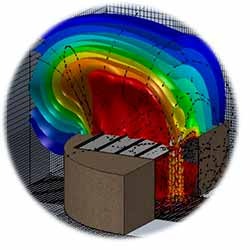 An online tool created by researchers in Penn State's College of Agricultural Sciences will enable manure storage pit designers to develop less dangerous facilities.
An online tool created by researchers in Penn State's College of Agricultural Sciences will enable manure storage pit designers to develop less dangerous facilities.
The online tool enables field engineers, farmers and safety professionals to predict how long a confined-space manure storage needs to be ventilated to remove toxic and asphyxiating gases. This information greatly reduces the risk of fatalities among farmers when entering on-farm manure pits.

Airflow through the animal living space in the barn above a manure storage also can be simulated by the new tool, so it can be used to determine whether animals need to be evacuated from all or a portion of the barn during pit ventilation. After information -- such as the barn design and dimensions, manure storage size, and ventilation configuration -- are fed into the design tool, customized information about the concentrations of toxic or asphyxiating manure pit gases is generated.
On-farm manure storage poses a significant hazard to agricultural workers due primarily to the danger of toxic and asphyxiating gas buildup. Farmers and service personnel occasionally need to enter these pits to conduct repair and maintenance tasks.
 Storage pits commonly contain hydrogen sulfide, carbon dioxide, methane and ammonia. Exact statistics are difficult to determine, but researchers estimate that about 10 people die each year in North American animal-manure pits. Worse yet, confined-space manure storage incidents too often result in multiple fatalities, with rescuers also succumbing while trying to aid a stricken person.
Storage pits commonly contain hydrogen sulfide, carbon dioxide, methane and ammonia. Exact statistics are difficult to determine, but researchers estimate that about 10 people die each year in North American animal-manure pits. Worse yet, confined-space manure storage incidents too often result in multiple fatalities, with rescuers also succumbing while trying to aid a stricken person.
With increased focus on preventing surface-water contamination, the number of such manure storage facilities on farms is growing steadily. According to the U.S. Department of Agriculture, the average farm size is increasing and the number of farms is decreasing, which likely is contributing to the growing number of manure pits.
The online design tool, which pit designers and field engineers can use to predict and understand airflow in confined spaces, is the culmination of a decade of research by a team of scientists in Penn State's Department of Agricultural and Biological Engineering. The results have been published in five journal articles, and an American Society of Agricultural and Biological Engineers safety standard was developed from the work.
"The reason we got involved in this is not only because people are dying each year, but also because of the tragic scenario of multiple deaths per incident," explained Harvey Manbeck, Distinguished Professor Emeritus of Agricultural Engineering. "The vision of the manure pit ag safety program at Penn State is for all on-farm, confined-space manure storage and handling facilities to have properly designed and installed ventilation systems specifically configured to reduce entry risk."
Manbeck and Dennis Murphy, Nationwide Insurance Professor of Agricultural Safety and Health, co-led the research project. Other team members include Virendra Puri, Distinguished Professor of Agricultural and Biological Engineering, who collaborated in evaluating and verifying the accuracy of solutions developed by the online tool, and Dan Hofstetter, research assistant in agricultural and biological engineering, who developed the input and output interfaces for the online tool.
The online tool is essentially a web interface that formats input data into a form suitable for a high powered simulation model. The web interface gathers input data from the user for various building dimensions and manure pit and barn ventilation system details and submits it to the simulation model for solving. The online design tool also includes a second interface that allows users to extract selected manure pit simulation results.
"You don't have to be a computational fluid design or computer assisted design expert to use the online design tool. Results include contaminant gas decay curves, real-time animations of gas decay and ventilation time required to reduce contaminate gas and replenish oxygen to acceptable levels for human entry," said Hofstetter.
"It's a cost-effective way for users to access the simulation tool. It's user-friendly -- not so complex that only a small percentage of engineers and safety professionals in the workforce could use it effectively. We wanted the design tool to be user-friendly so that a wide range of facilities planners, regulatory agency personnel and even emergency personnel could use it."
Agricultural building and manure pit designers and planners, as well as agricultural safety specialists and industrial hygienists, can use these design aid results to recommend minimum pit ventilation times and pit fan capacities to apply before human entry into the manure pit, Hofstetter added.
The design aid also can be used to explore alternative pit ventilation design details -- such as fan capacity, fan location, pit ventilation air outlet location -- and the source of pit ventilation air for both temporary portable or permanent pit ventilation system applications.
The design tool is available online. The website offers instructions, tutorials, workshop videos and a user's manual.

The work was funded by the Northeast Center for Occupational Health and Safety.
May 12, 2016 - PennState


